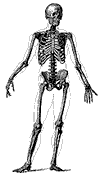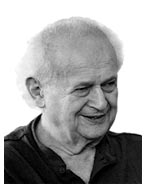- Home
page
- Training
Program
- Pre-training
Workshops
- Arlyn
Zones
- Olena
Nitefor
- Training
Prospectus
- How to apply
- About
Toronto
- Feldenkrais
Guild
- Standards
of Practice
- Contact
us
 |
 The Feldenkrais Method and The Feldenkrais Method and
Dr. Moshe Feldenkrais
PRE-CONFERENCE TRAINING WORKSHOP
Exclusively Awareness Through Movement -
Waking up the self organizing function
Exclusively Awareness Through Movement -
Waking up the self organizing function
In AY#478 (Chin movements on a chair) Moshe gives the following advice, "Do
it more easily at the points where it is difficult. Do not try to push more,
but at the points where it is difficult, do it more easily, a gentler movement,
more slowly. Then, slowly it will organize itself."
He does not say, " Do it more easily, a gentler movement, more slowly. Then,
slowly you will realize how to organize it."
In the contrast between these two statements lies the difference between self
organization and self correction: the difference between doing ATM to develop
intelligence, or doing ATM to simply feel better for a while or to move
properly.
In this advanced training we will examine how taking a particular attitude in
Awareness Through Movement wakes up and develops our self organizing
function. We will examine different uses of conscious attention. How are
attention,
self awareness and action used differently in self correction and differently
in self organization?
This is particularly complex for us practitioners. We fall into the double
trap of "knowing our patterns" and of thinking we know how "it should be." That
self knowledge often leads us to self correct, rather than to scrupulously
resist self correction, and engage in the process of self organization. The
place we do this the most, is in" self organization" while giving FI. What we
call self organization in FI, is usually just self correction. That's why we
continue to suffer from bad self organization. Sadly, even good correction can
lead to bad self organization!
Why? Because, good self organization does not mean proper movement mechanics.
Good self organization means using every single moment as a moment in which
our system is not so much settling into a solution, as continually seeking
improvement. It means staying alive in a process, not finding a result.
In AY# 96 (Sinking the spine between the shoulder blades) Moshe says, "Where
intelligence is involved, there isn't any limit to the extent to which it can
improve. Then, literally, throughout life you will never find a 'best way,'
that cannot be improved on. Then when you stop improving, it is a sign that it
has become a routine. You are acting mechanically and that is why it is not
improving; otherwise there is no limit to improvement."
The often asked question in our work is of course, how do I keep the change?
If self organization has to do with constant intelligent adjustments to ever
changing conditions, then there is nothing to keep. There is a process to
become more adept at. A process which must constantly navigate within the
known, while being open to discover and incorporate the as yet unknown.
These full five days will be devoted to ATM and the ongoing search of and for
intelligence. There will be lots to explore and re discover on that subject.
I have been wanting to teach an ATM only advanced training for quite a few
years, and am thrilled to finally do so.
We will "analyze" ATMs from many perspectives: the musculo-skeletal, the
functional, the developmental relationship between the ATMs we do, the learning
strategies, the development of the self organizing function and the surprise of
whatever questions emerge from the group. You will have a chance to follow
whatever personal themes you wish to explore at the moment, so that the
advanced can serve you in your own growth.
You will luxuriate in not having to learn any FI, but the principles we will
explore through ATM will inevitably improve your abilities in FI. It will be
splendid to really focus on understanding ATMs. If the occasional reference
to FI appears, we may give ourselves the permission to follow it.
* * * * *
The Feldenkrais Method
is a unique system, which uses sensory-motor learning as a means of improving all aspects of our everyday functioning. The Feldenkrais Method leads one to develop a more global awareness of oneself, and to discover new and deeply satisfying ways of using the entire self.
Over a number of decades, Dr. Moshe Feldenkrais (1904 - 1984) synthesized his vast knowledge in physics, engineering, judo, learning theory, Eastern traditions, biology and psychology into a method which shows that learning to learn is a prerequisite for a life in which change, improvement and maturation are possible at any age.
Moshe Feldenkrais, D.Sc., took his classical training in physics and engineering, and worked at the Curie Institute in Paris as a colleague of Nobel Prize laureate Frederic Joliot-Curie. Dr. Feldenkrais was an accomplished judo master and founded the first Judo club in Europe. His Method was born of a lifetime of inquiry into the relationship between movement, self-image and action. A distinguished scientist as well as a multi-faceted creative individual, Dr. Feldenkrais left an enduring legacy in his groundbreaking neurological and somatic education work, which came to be known as the Feldenkrais Method. He is considered to be one of the great pioneers in somatic education.
Results of Feldenkrais work include greater mobility, flexibility, and reduction or elimination of pain. Perhaps even more importantly, is the clear realization that we as humans have an extraordinary, innate capacity to both observe ourselves and to radically change our habitual ways of moving, thinking and acting. In discovering a form in which refinement of movement is the tool for developing awareness, Dr. Feldenkrais left behind a methodology, which improves self-esteem and quality of life.
The Feldenkrais Method is practiced in two inter-related, yet distinct, modes:
Awareness Through Movement®
Awareness Through Movement (ATM) lessons consist of a series of gentle, ingenious movements which are verbally directed, exploratory in nature and clarify the full range of possibility for human movement and action. Students learn at their own pace, in a non-competitive environment. By utilizing the inherent intelligence of the nervous system, each person discovers new ways of using themselves with more ease, grace and power.
Functional Integration
In Functional Integration® (FI) lessons, the practitioner communicates through gentle touch and movement. Through this non-invasive contact, the lesson facilitates improvement in the organization and coordination of the nervous, skeletal and muscular systems. Clients regain capabilities, which they had relinquished due to pain or "aging". As work progresses, clients report profound and lasting shifts in inner well being, connection to self, creativity, mood and outlook.
Results are in evidence among wide population segments that have benefited from the Feldenkrais Method. From children with congenital neurological challenges, to athletes, artistic performers, people sitting at computers, people suffering accident injuries, people going about their day-to-day life, and finally to gerentological applications where movement and mobility play such a large part in the quality of life of the elderly.
Moshe Feldenkrais provided a great gift of insight and methodology, which continues to change lives of both practitioners and their students. In this spirit of learning to create change, Feldenkrais Trainings Toronto proudly presents the 2005 Feldenkrais Practitioner Training Program.
The 2005 Feldenkrais Practitioner Training Program offers each participant a doorway into a new and fascinating profession as well as a chance to engage in his or her own process of personal transformation. |





 The Feldenkrais Method and
The Feldenkrais Method and